Blagdon Lake Birds
March 2014 News
Saturday 1st March
Sean Davies visited the lake today and reported seeing the Black-necked Grebe Podiceps nigricollis in Wood Bay and hearing a singing Chiffchaff Phylloscpous collybita near Top End.
I was up at 0500 hrs for a morning out with guide Newton George in search of water birds at the south end of the island of Tobago. We had a good morning, especially as I got to see 3 Masked Ducks (adult & immature ♂♂ and an adult ♀) at the second attempt - the bird that was top of my hit list. Lots of other water birds were seen including a Sora, Black-bellied Whistling Ducks, and Least Grebe with young. While in the mangroves looking for the mythical Mangrove Cuckoo (I dipped again) we saw Cocoa Woodcreeper. We dropped in to Grafton Bird Sanctuary as well and saw Black-faced Grassquit, 2 Blue-backed Manakins (adult & immature ♂♂), Olivaceous Woodcreeper, Rufous-breasted Wren and Scrub Greenlet that were new to me.
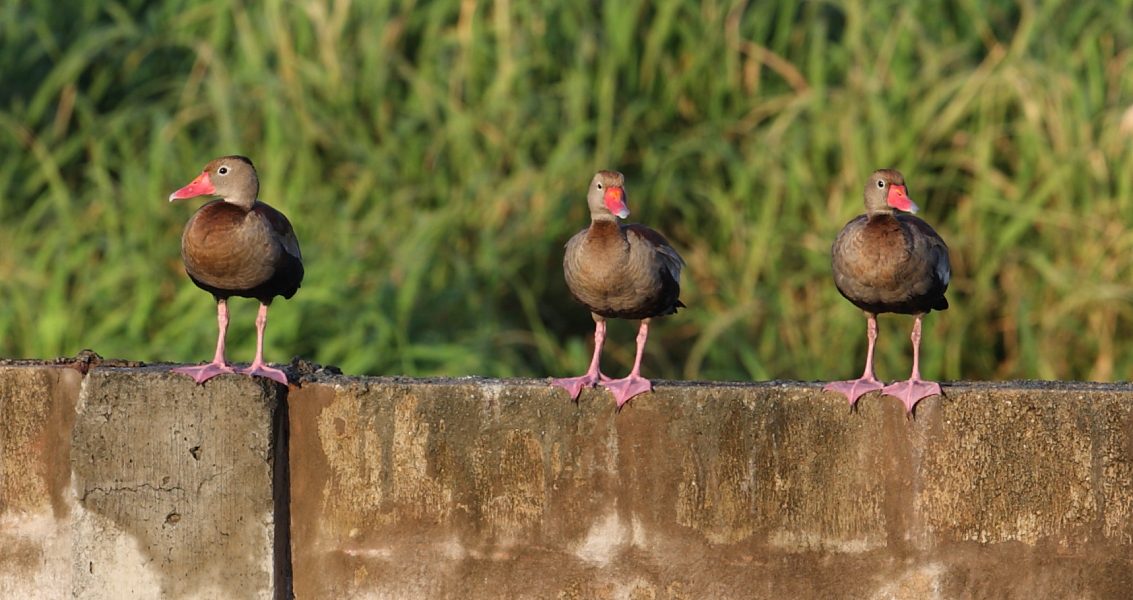
At last, a measure of success photographing the bats at the feeders. I set up the 24-70mm lens at 50 mm and positioned the camera on a tripod about a metre from the feeder with my 580EX set to hi-speed sync. The camera was put in manual and the shutter set to 1/2000th sec at f8. Although the bats were less inclined to come to the feeder I was targeting, I managed about half a dozen reasonable efforts out of about 50 shots taken in half an hour this evening.
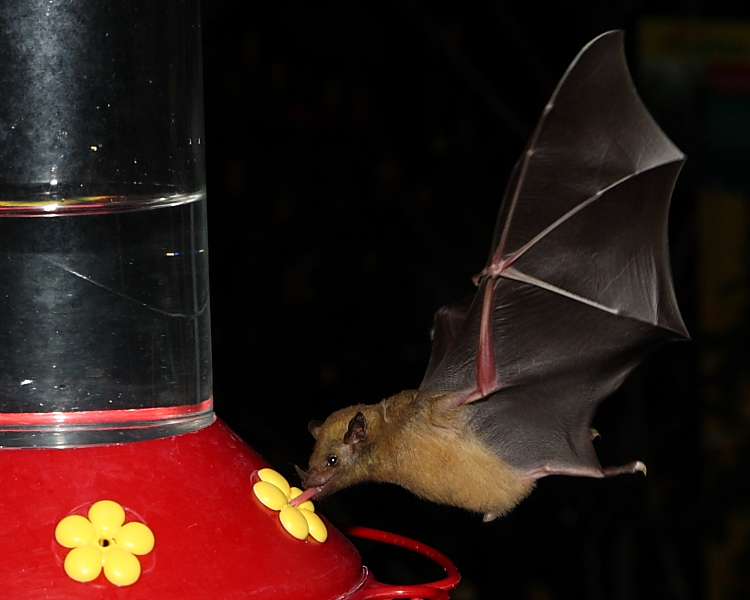

Sunday 2nd March
It looks like the weather hasn't improved too much back at home, and there is no news to pass on from the lake today.
I had a lazy day on Tobago too, where I'm still acclimatising to being out in the midday sun. I didn't do any birding as such, just took a stroll down into Plymouth village, where I saw Magnificent Frigatebirds over the coast and Laughing Gulls on the pier.
I took lots more photographs of the bats feeding again tonight and have started to put together a gallery of photos taken during the trip on my other website.
Monday 3rd March
No news from home today.
I've spent much of the day playing around with different camera / flash set-ups in order to photograph hummingbirds at the feeders. It's much harder than you'd think. The light didn't quite do this Ruby-topaz justice because the head should be bright red and the throat metallic gold, but you get the idea? It's a little cracker.
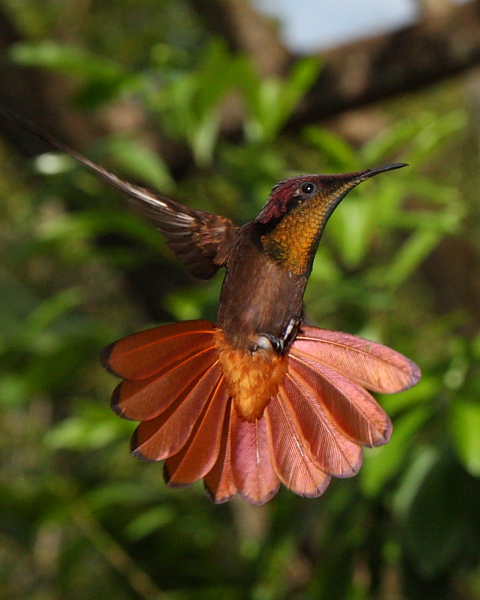
Stephen Davison and Linda Kergon (also on the Trinibats trip) arrived in Tobago today, but their plane arrived too late to allow us to do the proposed netting we had planned for this evening. It's a real shame because I have to leave for Trinidad tomorrow, as I couldn't get any flights or ferries later in the week. I had to make do with trying to get the ultimate shot of the Greater Long-tongued Bats drinking sugar water again tonight.
Tuesday 4th March
No news from the lake today.
I spent some time birding with Stephen and Linda this morning then transferred back to Trinidad and took the 2 hour taxi ride to Mount Plaisir. This is right on the Caribbean beach where Leatherback Turtles come to nest in their hundreds and this is the start of the nesting season. It is also the most reliable area to see Piping Guan early in the morning. Fingers crossed.
Wednesday 5th March
No news from the lake so far today.
A day for chilling on the verandah (which is right on the beach) with a cool beer or two. We're going to look for turtles with the protection team this evening. Looking out to sea, there have been a few Magnificent Frigatebirds, Brown Pelicans and Black Vultures going past. The Black Vultures are here probably with the sole intent of catching hatching turtles or stealing their eggs, but the conservation team do all in their power to enable as many as possible to get out to sea. I saw a Sooty Grassquit, which was new for me and as dusk fell there were plenty of bats along the top of the beach, which I recorded. There was one particularly large and black-looking bat that made a few passes.
Later in the evening, having paid the requisite fee, I was invited to go and watch a 500-600 kg ♀ Leatherback Turtle starting to excavate her nest. However, due to the sand consistency being wrong at her chosen site, she abandoned and eventually returned to the sea without laying any eggs. On the way back to base though, we came across another slightly smaller ♀ already starting to excavate so we watched her and she went through the whole process in about 1.5-2.0 hrs when we left her camouflaging the site. What a thrilling experience to witness.
Thursday 6th March
Paul Williams emailed to tell me that the Black-necked Grebe Podiceps nigricollis and Common Sandpiper Actitis hypoleucos are both still present at Blagdon today. Cheers Paul.
Friday 7th March
Steve Hale kindly emailed news of the Black-necked Grebe Podiceps nigricollis off Green Lawn this morning, though John Thorogood missed it this afternoon. On the other hand John reported 2 Common Shelduck Tadorna tadorna, a group of about 15 Fieldfares Turdus pilaris in the tops of the trees at Holt Copse and a Great Spotted Woodpecker Dendrocopos major that showed well at Bell's Bush. Three Common Buzzards Buteo buteo were flying together at Top End. He also said "not sure how many (Common) Goldeneye Bucephala clangula were present in total but nearly every time I stopped to scan around there were at least four in the scope, mostly females but several drakes. Looked along the dam when I arrived and again when I left but couldn't find a Common Sandpiper. Grey Wagtail Motacilla cinerea on the spillway though." Thanks guys. It doesn't sound like Spring has sprung back home yet.
This morning we visited Caroni Swamp where I saw Great Black Hawk and Cocoi Heron, both new birds, as well as Silky Anteater, and several Tree Boas, one of which bit leader Geoffery Gomes, one of leaders who was handling it - no lasting damage to either party though. I'm sorry I've had no time to post pictures as we went straight back out from lunch to trap bats this evening. We added a new species to the Trinibats list, Thomas's Yellow Bat Rhogeesa io.
Saturday 8th March
Roy Curber reported spring-like weather back at home and saw the Common Sandpiper Actitis hypoleucos on the dam but couldn't look for the Black-necked Grebe because the gates were locked.
Our team in Trindad visited a cave this morning to gather some data on a bat that roosts there, but due to issues with my ankles I didn't go up to the cave. However, after lunch with half of Trinidad on Maracas beach, we went up into the Northern Hill range to trap for the evening. Biggest surprise was the capturing of Oilbirds on no less than 8 occasions during the evening. Oilbirds are nocturnal feeders on the fruits of the oil palm and tropical laurels and are the only night-flying fruit-eating birds in the world. I also spotted a White-bearded Manakin and Boat-billed Kiskadee. We caught quite a selection of bats, but due to the late hour, everyone dived straight into bed when we got back. No doubt we'll put the list together tomorrow, when we have a slightly later start in order to visit the University of West Indies to look through their (pickled) bat collection.
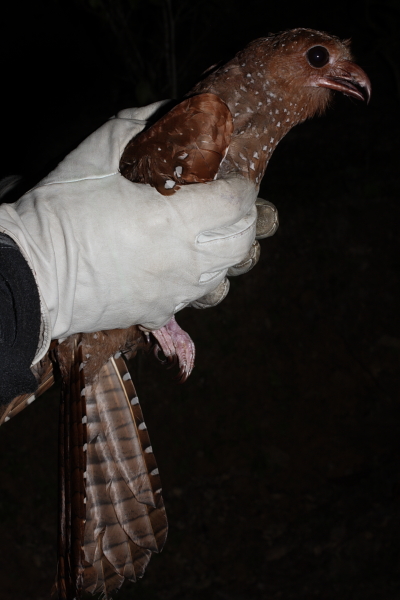
Sunday 9th March
No news from the lake.
We visited the Univ. of the West Indies this morning to look at their specimen collection then, after lunch, went up to the NW peninsula to do some more trapping. We had quite a good selection of bats during the evening and were serenaded by a showy Ferruginous Pygmy Owl on arrival. Sorry there's no more time to write more of a report but it's 0115 hrs and we're up for breakfast again at 0700 hrs for the long drive back up to Mount Plaisir in the NE of the country.
Monday 10th March
Ian and Caroline Stapp emailed to say they'd seen 4 singing Chiffchaffs Phylloscopus collybita at Green Lawn today in a cold north-easterly wind.
We drove up to Mount Plaisir at Grande Riviere again this morning, and after some lunch we went out to look for a cave where we were hoping to find a new species for the Trinibats trips. Much to everyone's delight we succeeded. There were some big numbers of bats caught by the teams working this evening. We got back to the beachside hotel at around 0030 hrs and some of us went out on the beach with the turtle workers and saw at least 8 Leatherback Turtles in one small area. A few others tried netting over the lagoon for Greater Fishing Bats unsuccessfully. I crawled into bed at about 0200 hrs.
Tuesday 11th March
No news from the lake today.
After less than 3 hrs sleep I got up before dawn and walked up the hill on my own hoping to see Trinidad Piping Guan. I wasn't exactly sure where to see them and duly failed in my mission, but enjoyed the walk all the same. After breakfast we had a look at a bat roost around the hotel and then drove back to Hacienda Jacana, Talparo, for lunch. Without time for anything else, we quickly packed our things and headed north back into the northern range for an all night batting session at high elevation on a ridge. We had a steady time at the top of the trail catching some 35 or so bats of 10 species, while the rest of the team quickly congregated at the very top of the ridge where they were having fantastic success, catching over 23 species, including a Common Vampire, at over 2000 feet elevation. Arriving back at the Hacienda Jacana at around 0900 hrs we sat up and had some breakfast and chatted about the evening before crawling into bed for 3 hrs sleep - when lunch was served!
Wednesday 12th March
Terry Grant reported the following sightings on the noticeboard at the Top End hide: ♂ Long-tailed Duck Clangula hyemalis, Black-necked Grebe Podiceps nigricollis, 5 Common Snipe Gallinago gallinago, 14+ Common Goldeneye Bucephala clangula, 3 Northern Shoveler Anas clypeata, 2 Eurasian Wigeon Anas penelope, 130+ RedwingsTurdus iliacus and 40+ Fieldfares Turdus pilaris.
After lunch we packed the kit and headed out to Maracas Waterfall in the Northern range and set up nets all the way up the trail from the car park to the waterfall. I was at the car pak where Stephen, Linda and I caught about 15 bats of 3 species. We were brought a couple of nice bats that were caught by other teams, that I photographed prior to their release. It's now 0215 hrs on Thursday morning and having had only about 6 hours sleep in 2 days, apart from some power naps, it's time to get my head down. I fly home tomorrow evening after a visit to some old ice houses, where we plan to map the use of the buildings by the various species of bats to be found there. Sorry the blog and photo gallery on my other website haven't been updated, but now at least you know the reason why, and hopefully I'll show you some nice pictures in due course. Just before he went to bed, Daniel told me a bat had flown in through the front door and out through the doors onto the verandah - he's probably dreaming about bats right now!

Thursday 13th March
No news from the lake today.
After visiting the ice houses this morning, where we sadly didn't find any Common Vampire Bats, we had lunch, a group photocall, then I had to get ready to fly home while the others set off for an evenings work at Asa Wright Nature Centre. I spent a few minutes chatting with Helen on the verandah about my trip during which she spotted a Grey-necked Wood Rail - my final new bird of the trip and a real last minute surprise.
Friday 14th March [Foggy]
It was lovely to see hedges full of blossoming Blackthorn as I made my way west along the M4 this morning and even though there was lots of patchy fog, I even saw a Red Kite. When I got home I was fairly busy, but when I had a few moments to spare this afternoon the fog had descended again, so I didn't bother to go down to the lake.
Saturday 15th March [Sunny with a westerly breeze]
Fishermen everywhere of course, as you'd expect on opening day! I saw 7 Eurasian Wigeon Anas penelope along the Indian Country bank and heard 3 ♂ Chiffchaffs Phylloscopus collybita singing along the south side. Also singing were a Pied Wagtail Motacilla alba yarrellii and a Eurasian Treecreeper Certhia familiaris. Common Coots Fulica atra are nesting and I saw a Common Blackbird Turdus merula collecting nesting material. A few Meadow Pipits Anthus pratensis were noted around the Green Lawn / Long Bay area.
Dean Reeves reported 7 Sand Martins Riparia riparia.
I checked the board at Top End hide and saw an interesting report for 12th March by Terry Grant that included a ♂ Long-tailed Duck Clangula hyemalis as well as the Black-necked Grebe Podiceps nigricollis (see news for that day).
Sunday 16th March [Sunny with a cool westerly breeze]
I saw a couple of ducks flying, that looked like a pair of Long-tailed, while I was walking along with my binoculars. They landed in rough water off Ash Tree, so I went back for my scope and half an hour later found a ♂ Long-tailed Duck Clangula hyemalis, but no sign of what I thought was a second bird that flew in with it. We will be carrying out the WeBS count tomorrow so we'll have plenty of opportunity for a more thorough search. I didn't see the Black-necked Grebe either, but the wintering Common Sandpiper Actitis hypoleucos was on the dam wall. When I arrived late morning, there were circa 100 Lesser Black-backed Gulls Larus fuscus sitting on the water with a handful of Herring Gulls Larus argentatus among them. I presume they are migrants on their way through the area.
There were at least 6 Small Tortoiseshells Aglais urtica flying in the sushine.
Monday 17th March [Cloud, then sun, mild, with a light breeze]
At 0930 hrs Phil Delve picked out a large white-winged gull among a flock of mainly Lesser Black-backed Gulls Larus fuscus from the dam. Careful observation, and comparison with gulls alongside it, enabled us to clinch the identification as a juvenile Iceland Gull Larus glaucoides (3rd lake record). While we were noting salient features, it finished washing and flew off west with most of the LBBs.
The Common Sandpiper Actitis hypoleucos was on the dam wall and sure enough, when I eventually caught sight of the ♂ Long-tailed Duck Clangula hyemalis I'd seen yesterday afternoon (mainly white head - winter plumage), it was feeding alongside a second ♂ Long-tailed Duck (this one with a darker head - going into summer plumage). Both had clear pink bands on their bills and had long white scapular feathers still. Neither appeared to have long tails. I'd love to know which of the two Terry Grant saw last Wednesday - if you read this, perhaps you'd let me know Terry? We last saw the Long-tailed Ducks swimming towards Rugmoor late morning, and didn't see them at all as we walked back from Top End after completing the count early afternoon. We didn't see any Sand Martins or the Black-necked Grebe during the WeBS count. However, I did hear 2 singing Eurasian Nuthatches Sitta europaea; one at the Spillway and one well along Butcombe Bank.
There was nothing of note in the small gull roost this evening, but there was a pair of Common Shelducks Tadorna tadorna on Green Lawn.
Tuesday 18th March [A strong WSW wind blowing down the lake. Cool & dry.]
Nothing much to report today. No sign of the Long-tailed Ducks or any hirundines. A Black Swan Cygnus atratus has arrived back at the lake and, when I left, was on Holt Farm fields feeding with adult Mute Swans Cygnus olor. A ♂ Eurasian Sparrowhawk Accipter nisus skimmed over the bonnet of my car at Hellfire Corner.
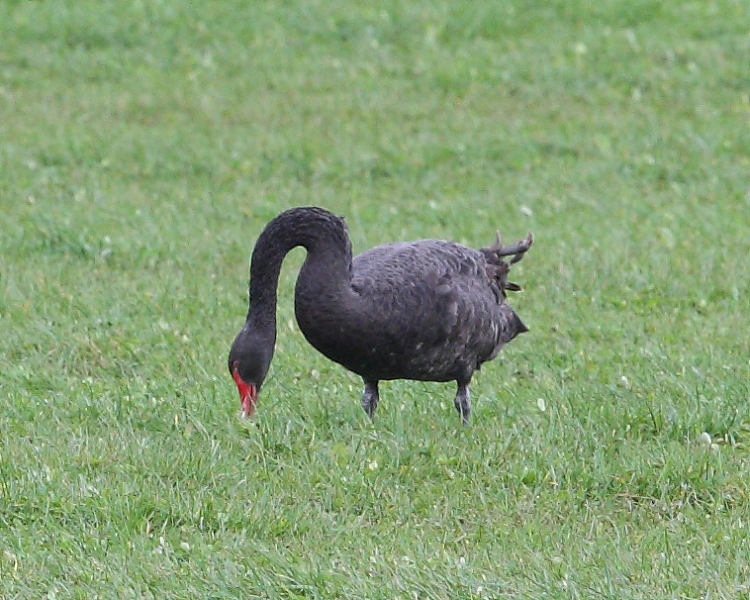
For those interested in the fossil origin of birds, it should be worth watching Fossil Wonderlands: Nature's Hidden Treasures on BBC4 at 2100 hrs this evening.
Wednesday 19th March [Cool and overcast with a light westerly breeze]
I thought I'd glimpsed the 2♂♂ Long-tailed Ducks Clangula hyemalis briefly through my bins yesterday from Rainbow Point, but after half an hour of searching with my telescope I concluded I must have been mistaken. However, there they were again today, in the same area off Ash Tree / Peg's Point. When actively feeding, they spend a great deal of time underwater and very little time on the surface when you might catch sight of them. The Common Sandpiper Actitis hypoleucos was on the dam wall and the pair of Common Shelducks Tadorna tadorna were ranging about, but there was no sign of the Black Swan. Some gulls dropped in to wash during the morning, including a few Common Gulls Larus canus that have yet to head north (and/or east) to their breeding grounds.
Thursday 20th March [Pleasant, with a strong southerly breeze]
The 2♂♂ Long-tailed Ducks Clangula hyemalis were still present this morning, and despite spending 2 hours driving backwards and forwards from the north to south shores I was not able to get anywhere near enough to get decent photos.They're a nightmare!
Also this morning, a decent flock of circa 100 Sand Martins Riparia riparia was over the dam end, Sue and John Prince spotted a late Redwing Turdus iliacus, the Common Sandpiper Actitis hypoleucos was on the dam and I heard a few more Chiffchaffs Phylloscopus collybita singing. Joanna Dailey emailed today to say there are a few Ospreys back on their territories in Wales and Rutland, so keep your eyes peeled, the southerly winds will be speeding their passage northward, though I don't expect any to hang around like they did last year in the bad weather.
I'm starting a walk from the Lizard to the north of England tomorrow (the first day of Spring), though the weather forecast is awful, so if anyone has any news over the weekend I'd be pleased to acknowledge it.
Friday 21st March
♂ Gadwall Anas strepera at Bell's Bush, reported and photographed by Nick Willcox-Brown.
I started my End-to-end Walk (E2E) from Lizard Point today. I walked 16 miles to Porthleven.
Saturday 22nd March
Mike O'Connor sent the following news: A flock of about 9 (Common) Redshanks Tringa totanus over Holt Bay late morning. We later saw feeding on the dam. Also 15 (Common) Goldeneye Bucephala clangula visible opposite the hide and lots of Sand Martins Riparia riparia generally on the lake, particularly Holt Bay area.
The 2♂♂ Long-tailed Ducks Clangula hyemalis were reported today on Steve Hale's Avon Birds by Chris Johnson (thanks Steve). He also reported 1 Common Buzzard Buteo buteo, 1 Common Kestrel Falco tinnunuculus, 1 Grey Heron Ardea cinerea, 4 Great Cormorants Phalacrocorax carbo, 6 Pied Wagtails Motacilla alba yarrellii and 200+ Sand Martins Riparia riparia. No Osprey!
Also reported to me by angler Andrew Chastney the following late news: "Just for your info, I saw a Eurasian Spoonbill Platalea leucorodia over Blagdon yesterday (Sat 22nd March) I was fishing early morning at Green Lawn and looked up to see a large white bird overhead with a that distinctive bill! It was flying from the north shore and turned west over me heading down towards the dam, I lost sight of it." Andy has sent me some notes that I've forwarded to John Martin (Avon Bird Recorder). If accepted, this would be the 2nd lake record.
It was my 2nd day walking E2E today. I covered 12 miles from Porthleven to Marazion.
Sunday 23rd March
Sean Davies emailed "Both of the ♂ Long-tailed Ducks Clangula hyemalis were still present this lunchtime from Wood Bay Point. The Barrow Gurney one is definitely different." Mike O'Connor also emailed "No rarities, but a huge number (been thinking about how you would actually estimate the number and came to the conclusion - its tricky!) of Sand Martins Riparia riparia, mostly low over the lake surface but a lot higher-up as well, mid-afternoon. Incredible sight." Thanks guys, I'm feeling homesick already!
See yesterdays news of Eurasian Spoonbill seen in flight early morning.
I walked from Marazion along the sea front through Penzance and Newlyn to Lamorna Cove today. 9.6 miles. I saw ONE Sand Martin, but I also got Purple Sandpiper at Penzance Lido and a load of Ruddy Turnstones and a Sandwich Tern on the way. It later transpired that the black duck I was trying to identify with my bins, unsuccessfully, was a Surf Scoter in the bay, though I didn't see the reported Kumlien's Gull despite checking everything I saw along the way. If the weather is half as bad as they promise tomorrow, I might abandon and come home to do some birding...
Monday 24th March [Steady rain from mid-afternoon]
This afternoon I saw the 2♂♂ Long-tailed Ducks Clangula hyemalis in flight at Flower Corner and the Common Sandpiper Actitis hypoleucos in flight at Cheddar Water. There were several hundred Sand Martins Riparia riparia over the lake among which I saw a single Barn Swallow Hirundo rustica off Rugmoor Point. There were 4 Common Snipe Gallinago gallinago in the grass at Holt Bay as I drove past and I saw at least 7 Eurasian Teal Anas crecca and 4 Gadwall Anas strepera (3♂♂) during my visit.
The weather was awful in Cornwall this morning. Driving through Penzance and Newlyn the waves were blowing over the prom and road, depositing seaweed. I went on to Lamorna Cove with the intention of walking but driving rain (forecast all day) and waves crashing up the cliffs made me decide it would probably be a bit foolhardy to set out on my own along the desolate path towards Land's End in such conditions.
Tuesday 25th March [Overcast with a cool breeze]
I met Chris Stone late morning and we spent a couple of hours birding together until I got too cold (suffering from 'man flu' at the mo), but we didn't manage to locate the Long-tailed Ducks or the Common Sandpiper, and Chris has just texted to say there are 2 Long-tailed Ducks at Chew. Aside from a few singing Chiffchaffs Phylloscopus collybita and the flock of 200 or so Sand Martins Riparia riparia you'd hardly know it was spring.
Wednesday 26th March [Sunny spells but with a cold northerly breeze]
Again, not much to write home about today. 2 Common Shelducks Tadorna tadorna flew west, about 250 Sand Martins Riparia riparia, a few Chiffchaffs Phylloscopus collybita and some lingering Fieldfares Turdus philomelos at Holt Copse were expected. While 2 pairs of Northern Shoveler Anas clypeata and a single ♀ Eurasian Wigeon Anas penelope were new in. I kept looking up for an Osprey to come through, but the only interest skyward were the gulls and 15, or so, paragliders hanging over Ubley Rising.
Thursday 27th March [A watery sun and stiff easterly breeze]
I heard my first Blackcap Sylvia atricapilla singing at Ash Tree this morning, and the Sand Martin Riparia riparia flock may be slightly larger at circa 300 birds. I've recorded 86 spp. in 86 days at the lake this year so far - see phenology page. There are reasonable numbers of Black-headed Gulls Chroicocephalus ridibundus feeding over the lake in tern-like fashion, as well as the Sand Martins, probably feeding on black chironomids. Indeed, the few Eurasian Teal Anas crecca are also feeding well out in the lake on the chironomids, either as they hatch or as pupae just under the surface. Jeff Hirst spooned a trout yesterday lunchtime and it had large black buzzers (chironomids) in the stomach but as he pointed out, they were all dead. This suggests that they had been eaten as they were hatching earlier in the day, rather than just before the trout was caught at lunchtime.
As there's not much happening on the bird front yet, I decided to have a look at the flowers and noted that whilst Primroses Primula vulgaris and False Oxlips Primula x polyantha are out on both sides of the lake, Cowslips Primula veris are in flower on the north side only. No doubt this is due to the sloping southerly aspect of the meadows over there.
I'm itching to get on and do some bat transects but it's still too cold and windy at night. When I looked at the Blagdon Weather Station before I went to bed last night it was 2 Celsius.
Friday 28th March [Rain and murky for much of the day]
There was an increase in the number of Sand Martins Riparia riparia over the lake today. DN (Dave Nevitt?) suggested circa 700 on the Top End hide board, and I wouldn't disagree with that. There was nothing else new of note, but we can hope the warmer weather promised for the weekend will change all that!
Saturday 29th March [Warmer and sunny]
I spent a couple of hours at the lakeside around lunchtime and saw nothing to report whatsoever. I met Roy Curber who'd seen a late Redwing Turdus iliacus in flight along the south side near Holt Copse. All the Sand Martins Riparia riparia had moved on.
However, I went back to the lake at dusk in order to walk a bat transect from the dam to Holt Bay, and saw a Tawny Owl Strix aluco at Cheddar Water and heard a Common Redshank Tringa totanus over the dam end at 1915 hrs. I also bumped into John Harris, Head Fishery Ranger, who told me he'd just seen what he felt sure was an Osprey at Chew, that was mobbed by 2 gulls as it flew off north over the dam.
The bat transect was really busy; I recorded all 3 Pipistrelle species, Noctules and Lesser Horseshoes at least, though I have yet to analyse the recordings. There were probably at least 4 different Nathusius's Pipistrelles Pipistrellus nathusii along the 2km walk.
Sunday 30th March [Sunny and warm]
There were 4 Little Gulls Hydrocoloeus minutus (3 adults and a 1st-winter/summer) at the dam end around 1045 hrs. I spent 3 hours earlier carrying out a singing bird survey, highlights of which were 29 Chiffchaffs Phylloscopus collybita, 10 Blackcaps Sylvia atricapillus, 52 Wrens Troglodytes troglodytes and a Eurasian Nuthatch Sitta europaea (at Hellfire Corner).
I recorded 5 different Nathusius's Pipistrelles Pipistrellus nathusii last night. See results.
This evenings transect was along the North Shore and it was absolutely alive with bats. I recorded hundreds of Soprano Pips, lots of Common Pips and a good number of Nathusius's Pips, a Serotine, a Lesser Horseshoe, Nyctalus sp. and Myotis sp. Some of the spectrograms were absolutely jammed with echolocation calls all over one another. When you listen to them slowed down 1/10 speed there's just a wall of sound - it must have been deafening for the bats! It looks like I recorded 7 Nathusius's Pipistrelles.
After I finished, I met Chris Barrington of YACWAG on the dam and he told me he'd just been watching 2 Otters Lutra lutra at the Spillway while he was recording bats. One of them even came out of the water and along the road towards him as if it was investigating the source of the sounds from his bat detector - I wonder if the chattering bat calls sounded like a young Otter?
Monday 31st March [Warm and overcast, threatening rain]
The 2♂♂ Long-tailed Ducks Clangula hyemalis are back. Blagdon angler Clive Eastman stopped me and asked what the two 'strange' ducks in Wood Bay were. I for my sins, had totally missed them, so he took me back in the car and I was able to identify and show them to him in the scope. Another Blagdon angler, Jeff Hirst, also stopped for a chat and reported his first sighting of a Grass Snake Natrix natrix this year - it swam across Butcombe Bay making landfall right next to where he was wading. A single Common Snipe Gallinago gallinago, flushed as I walked over the bridge at Long Bay, was about all I could muster aside from 4 adult Common Shelducks Tadorna tadorna which flew in from the east and landed off Orchard Bay this afternoon. No hirundines or Willow Warblers seen or heard today.